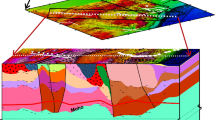Abstract
— Seismic event locations based on regional 1-D velocity-depth sections can have bias errors caused by travel-time variations within different tectonic provinces and due to ray-paths crossing boundaries between tectonic provinces with different crustal and upper mantle velocity structures. Seismic event locations based on 3-D velocity models have the potential to overcome these limitations. This paper summarizes preliminary results for calibration of IMS for North America using 3-D velocity model. A 3-D modeling software was used to compute Source-Station Specific Corrections (SSSCs(3-D)) for Pn travel times utilizing 3-D crustal and upper mantle velocity model for the region. This research was performed within the framework of the United States/Russian Federation Joint Program of Seismic Calibration of the International Monitoring System (IMS) in Northern Eurasia and North America.¶An initial 3-D velocity model for North America was derived by combining and interpolating 1-D velocity-depth sections for different tectonic units. In areas where no information on 1-D velocity-depth sections was available, tectonic regionalization was used to extrapolate or interpolate. A Moho depth map was integrated. This approach combines the information obtained from refraction profiles with information derived from local and regional network data. The initial 3-D velocity model was tested against maps of Pn travel-time residuals for eight calibration explosions; corrections to the 3-D model were made to fit the observed residuals. Our goal was to find a 3-D crustal and upper mantle velocity model capable predicting Pn travel times with an accuracy of 1.0–1.5 seconds (r.m.s.).¶The 3-D velocity model for North America that gave the best fit to the observed travel times, was used to produce maps of SSSCs(3-D) for seismic stations. The computed SSSCs(3-D) vary approximately from +5 seconds to −5 seconds for the western USA and the Pre-Cambrian platform, respectively. These SSSCs(3-D) along with estimated modeling and measurement errors were used to relocate, using regional data, an independent set of large chemical explosions (with known locations and origin times) detonated within various tectonic provinces of North America. Utilization of the 3-D velocity model through application of the computed SSSCs(3-D) resulted in a substantial improvement in seismic event location accuracy and in a significant decrease of error ellipse area for all events analyzed in comparison both with locations based on the IASPEI91 travel times and locations based on 1-D regional velocity models.
Similar content being viewed by others
Author information
Authors and Affiliations
Additional information
(Received April 28, 1999, revised November 18, 1999, accepted February 9, 2000)
Rights and permissions
About this article
Cite this article
Ryaboy, V., Baumgardt, D., Firbas, P. et al. Application of 3-D Crustal and Upper Mantle Velocity Model of North America for Location of Regional Seismic Events. Pure appl. geophys. 158, 79–103 (2001). https://doi.org/10.1007/PL00001169
Issue Date:
DOI: https://doi.org/10.1007/PL00001169




